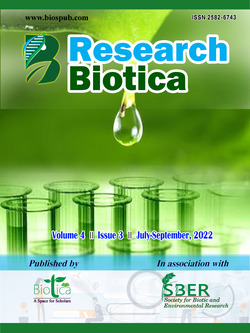
Evaluation of Botanical Soaps for the Management of Pigeonpea Insect Pests
Zadda Kavitha*
Agricultural College and Research Institute, Tamil Nadu Agricultural University, Madurai, Tamil Nadu (625 104), India
Vijayaraghavan C.
Regional Research Station, Tamil Nadu Agricultural University, Vridhachalam, Tamil Nadu (606 001), India
DOI: https://doi.org/10.54083/ResBio/4.3.2022/139-145
Keywords: Indoxacarb, Neem soap, Pod damaging insects, Pungam soap
Abstract
A two year consecutive trial was conducted during kharif 2014-15 and kharif 2015-16 to evaluate neem and pungam soaps @ 10 g l-1 in alone and in combination with indoxacarb (0.5 ml l-1). First spray was given during flowering and second spray was given after fifteen days of the first spray. In both the field trials, neem soap followed by indoxacarb was effective against pigeonpea pod damaging insects followed by pungam soap and indoxacarb. During kharif 2014-15, two sprays of neem soap was on par in efficacy with pungam soap followed by indoxacarb against H. armigera and M. vitrata. When the damage of the pod damaging insects in botanical sprays alone treatments and untreated control was compared, these treatments were effective and good control was achieved. During kharif 2015-16, two sprays of neem soap was on par with NSKE followed by indoxacarb and pungam soap followed by indoxacarb in reducing the damage of H. armigera. In case of M. vitrata, two sprays of neem soap and two sprays of NSKE recorded 50.4 and 44.9% reduction over control and were on par with NSKE followed by indoxacarb in effectiveness. Against plume moth, two sprays of neem soap (4.3% damage) and two sprays of NSKE (5% damage) were on par with pungam soap followed by indoxacarb (4.7% damage).
Downloads
not found
Reference
Ameh, S.A., Ogunwolu, E.O., 2000. Comparative effectiveness of aqueous plant extracts and lambda cyhalothrin in controlling post flowering insect pests of cowpea in the Southern Guinea savanna of Nigeria. In: Entomology in Nation Building: The Nigerian Experience. (Eds.) Dike, M.C., Ajayi, O., Okunade, S.O., Okor-onkwo, N.O. and Abba, A.A. The Proceedings of ESN 30th Annual Conference held at Kano, Nigeria, 4th-7th October 1999, Kano, Nigeria. pp. 175-180.
Bottenberg, H., Singh, B.B., 1996. Effect of neem leaf extract applied by broom method on cowpea pests and yield. International Journal of Tropical Pest Management 42, 207-209.
Jackai, L.E.N., Inang, E.E., Nwobi, P., 1992. The potential for controlling post-flowering pests of cowpea, Vigna unguiculata Walp. using neem Azadirachta indica A. Juss. Tropical Pest Management 38, 56-60.
Jackai, L.E.N., Oyediran, I.O., 1991. The potential of neem, Azadirachta indica A. Juss. for controlling post-flowering pests of cowpea, Vigna unguiculata Walp. I. the pod borer, Maruca testulalis. Insect Science and its Application 12, 103-109.
Mohapatra, S.D., Srivastava, C.P., 2002. Bioefficacy of chemical and biorational insecticides against incidence of legume pod borer, Maruca vitrata (Geyer) in short duration pigeonpea. Indian Journal of Plant Protection 30(1), 22-25.
Pandey, S.A., Das, S.B., 2016. Evalution of biopesticides against gram pod borer Helicoverpa armigera (HUB.) on pigeonpea. Legume Research 39(3), 479-481.
Sambath, S.K., Durairaj, C., Ganapathy, N., Mohankumar, S., 2015. Field evaluation of newer insecticide molecules and botanicals against pod borer of red gram. Legume Research 38(2), 260-267.
Sharma, H.C., 1998. Bionomics, host plant resistance and management of legume pod borer, Maruca vitrata - A review. Crop Protection 17, 373-386.
Subharani, S., Singh, T.K., 2010. Biology of pod fly, Melanagromyza obtusa on Cajanus cajan in Manipur. Annals of Plant Protection Sciences 18, 67-69.
Tiwari, A.K., Shivhare, A.K., 2016. Pulse in India Retrospect and Prospect. Directorate of Pulse Development, Bhopal (M.P) 462004, India. pp. 1-2.
Veda, O.P., 1993. Effect of weather factors on the incidence of pod bug, Clavigralla gibbosa Spinola (Hemiptera: Coreidae) in pigeonpea. Indian Journal of Entomology 55(4), 351-354.
